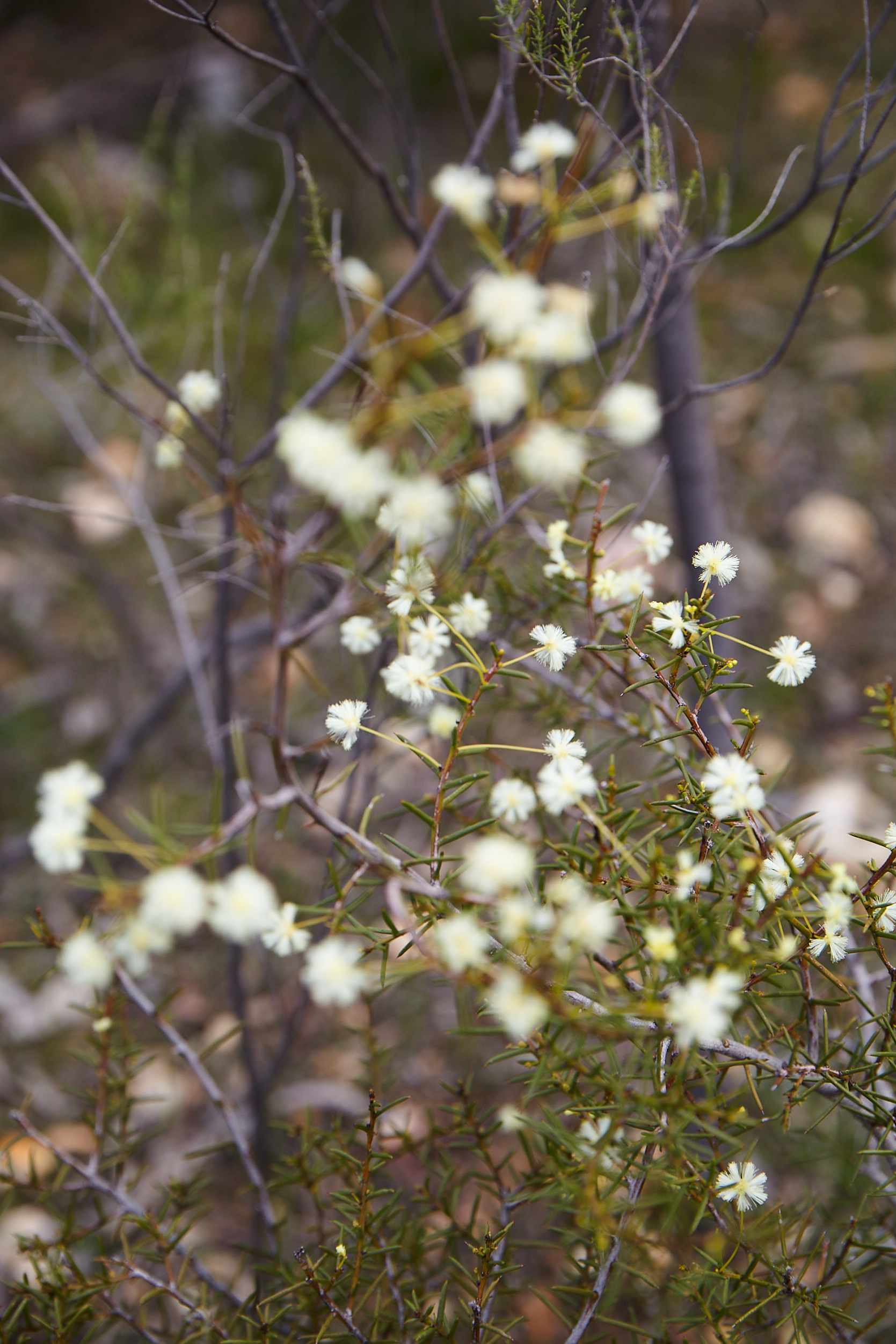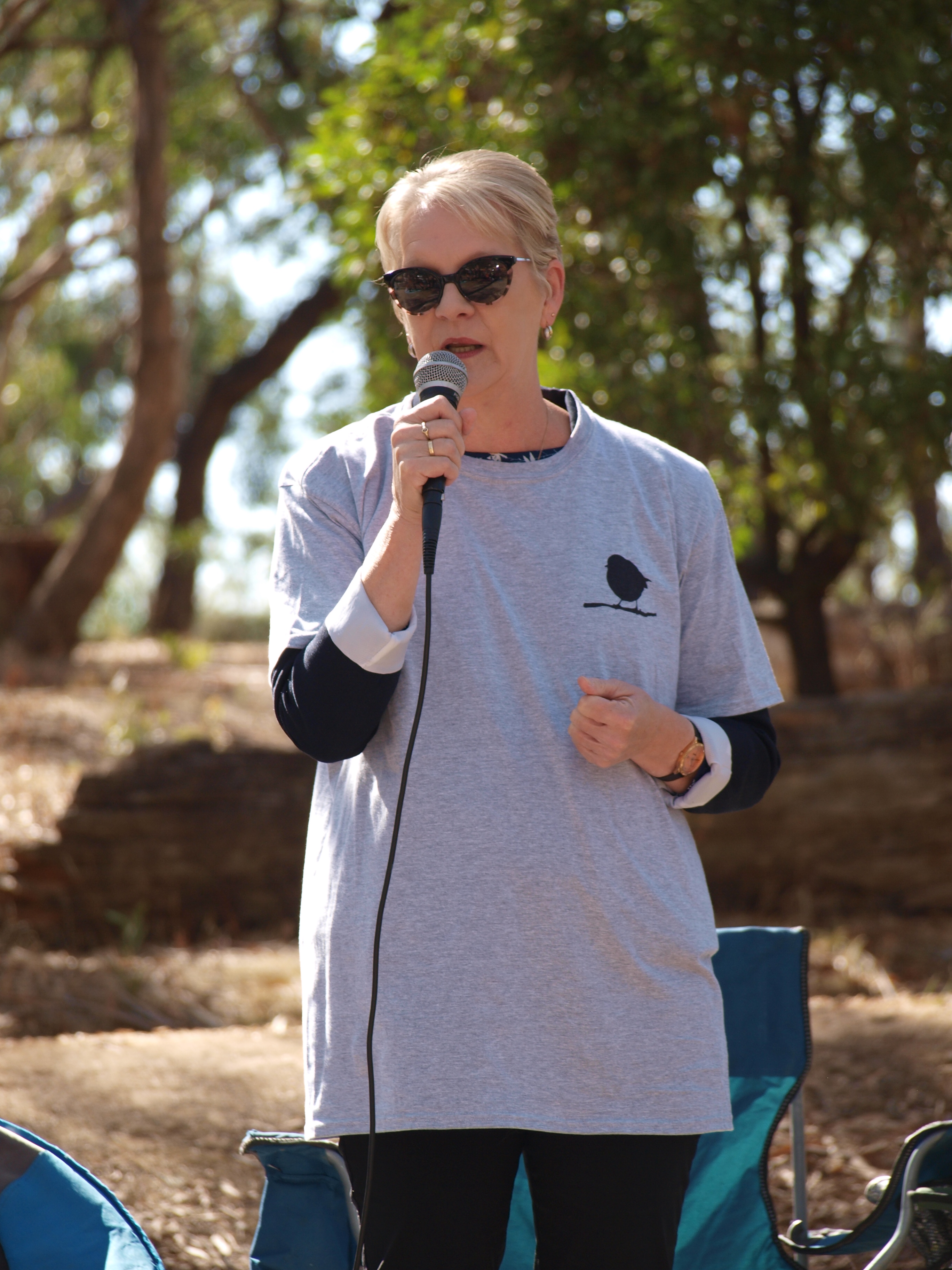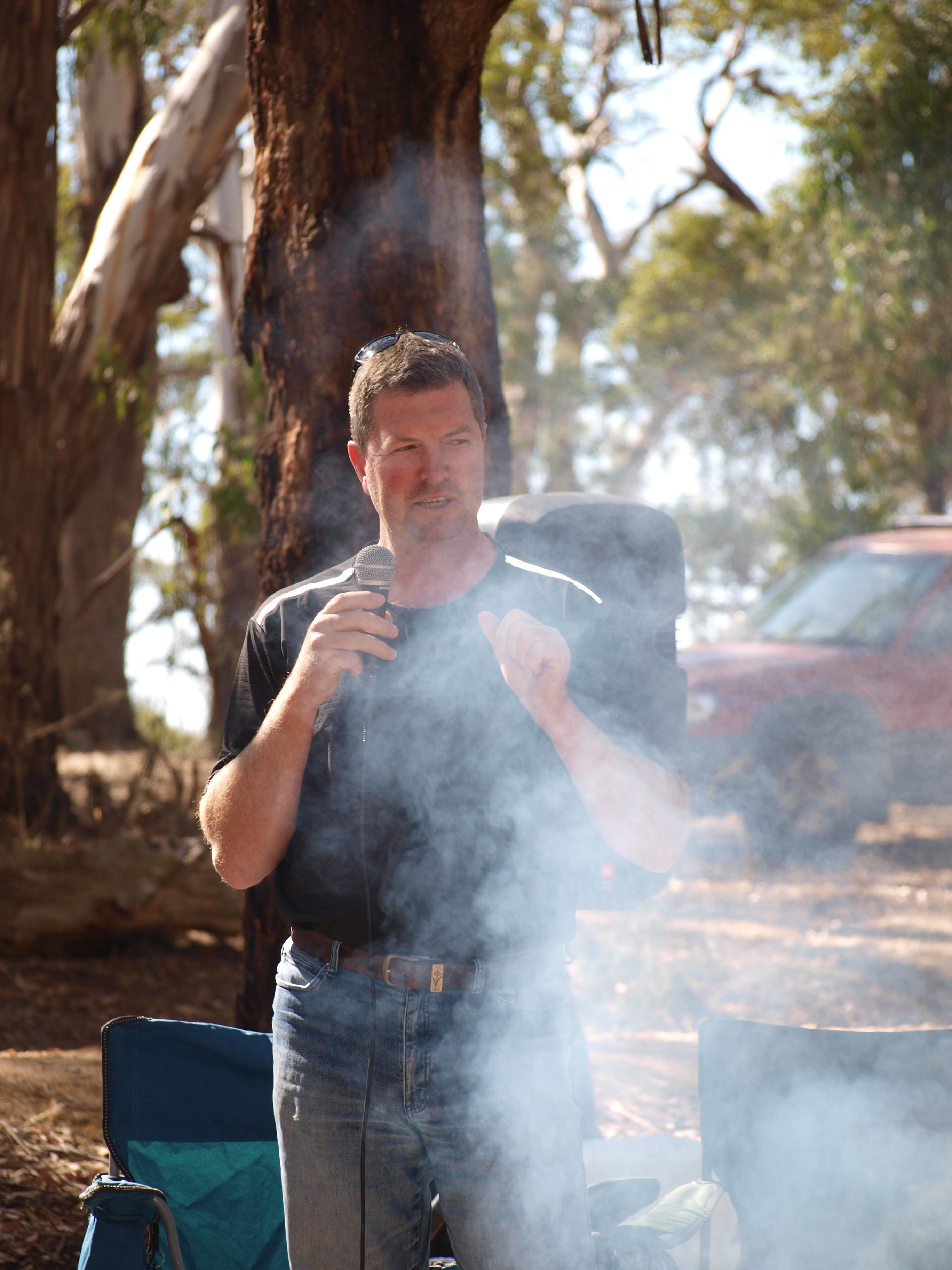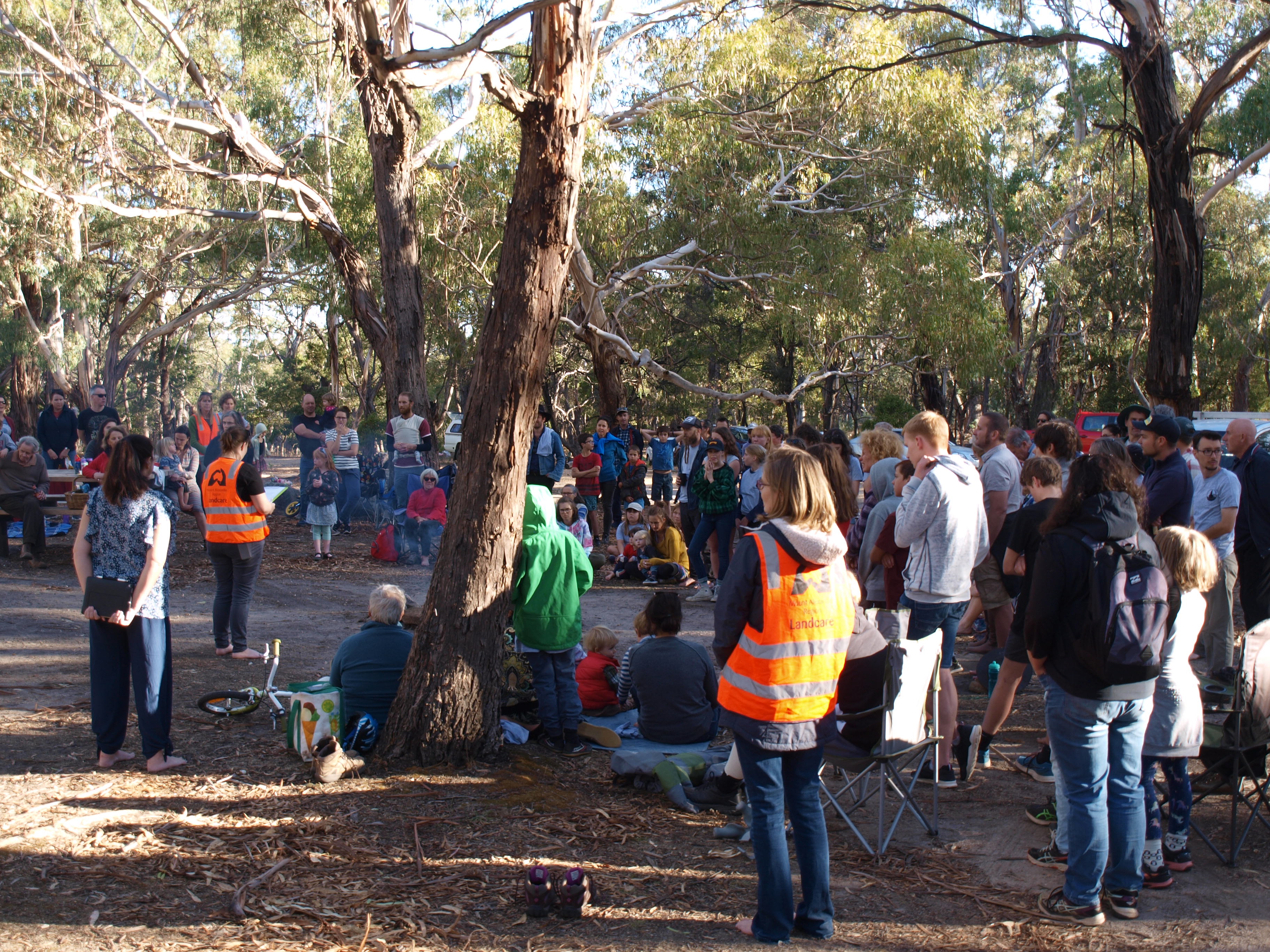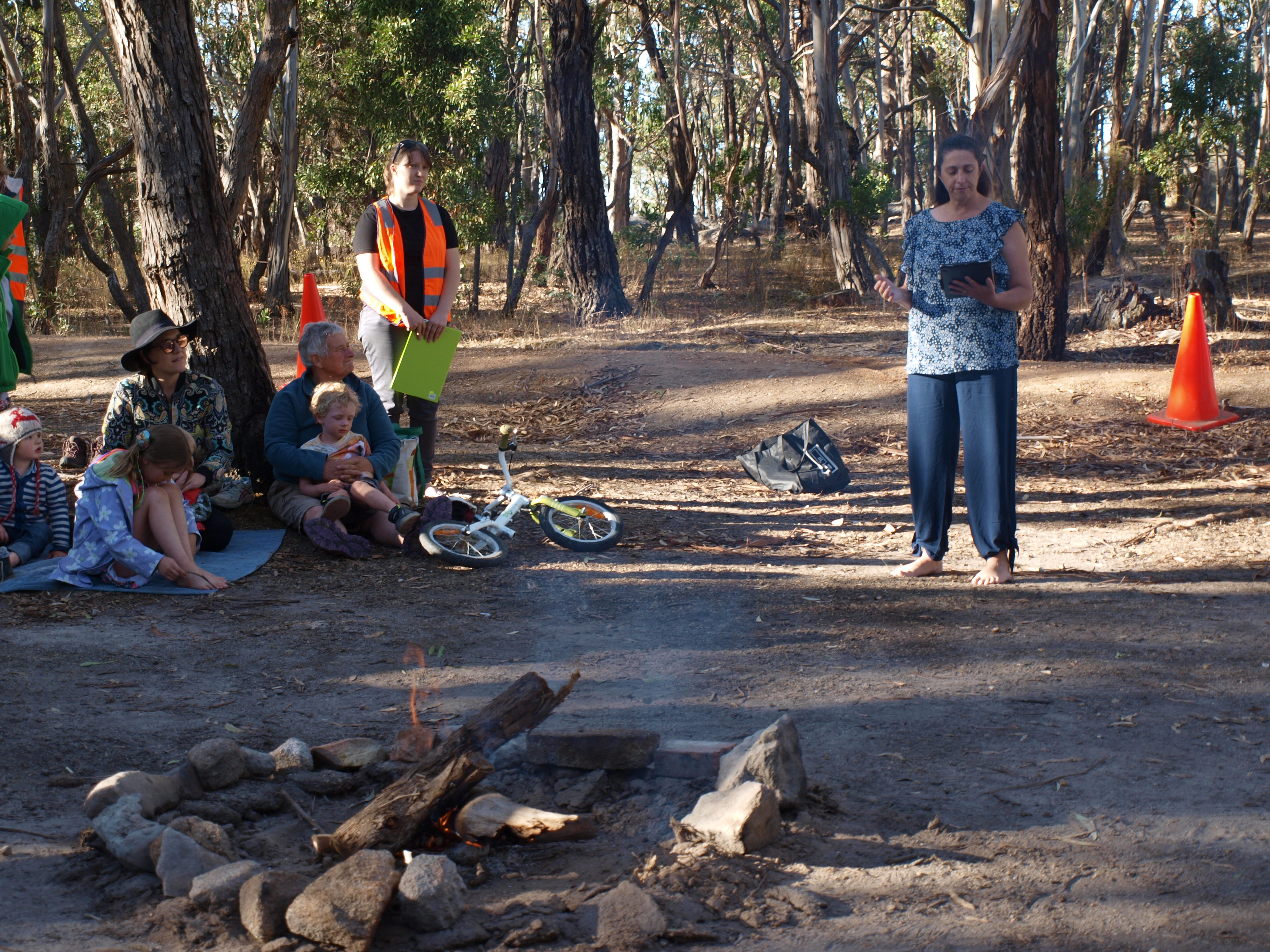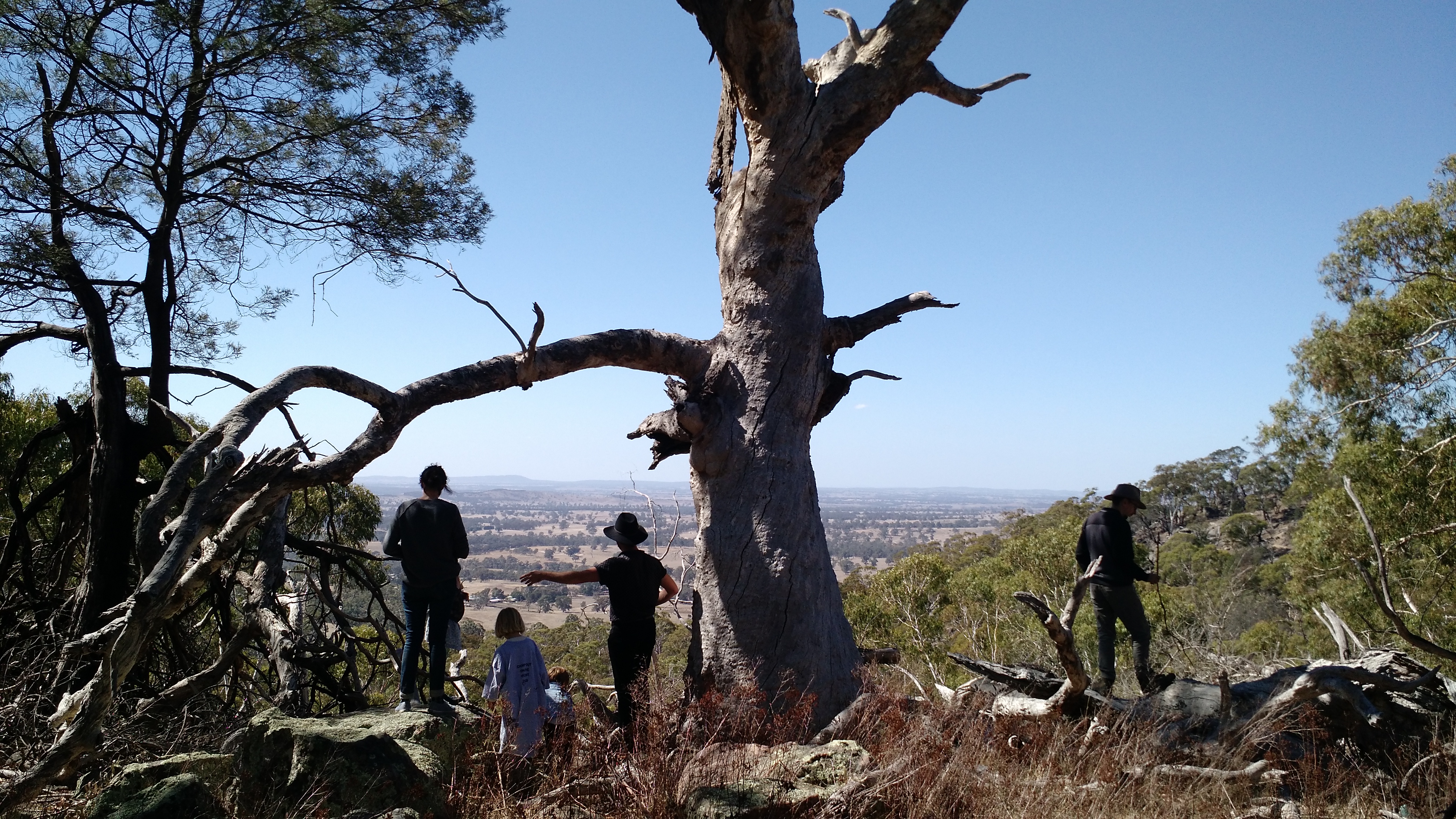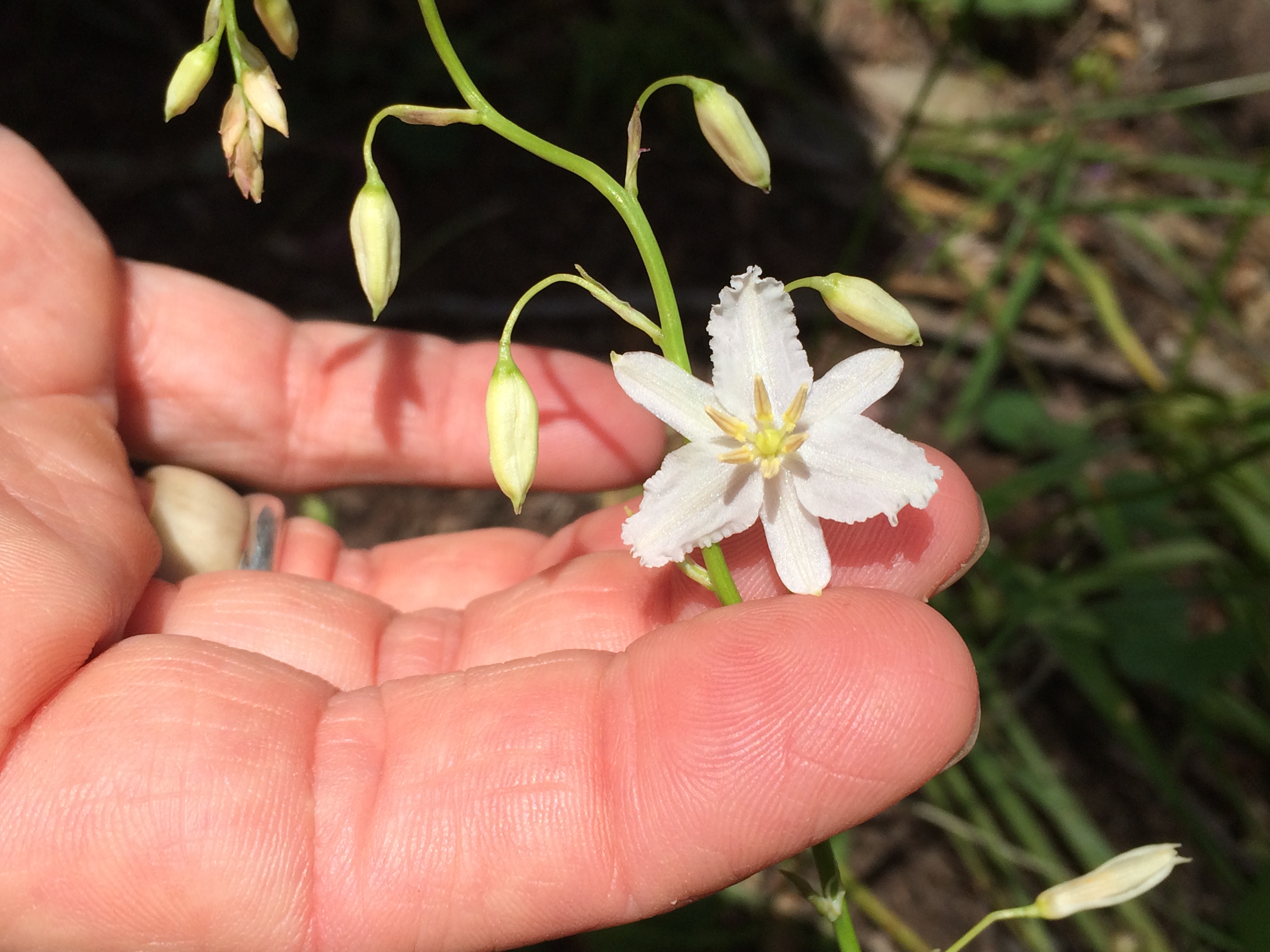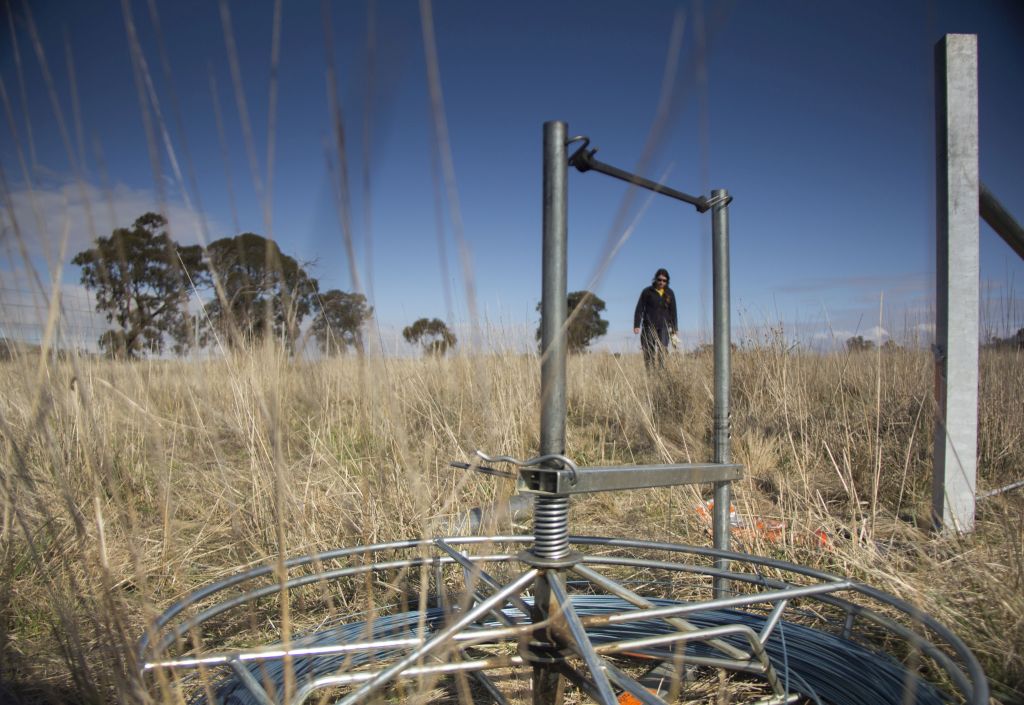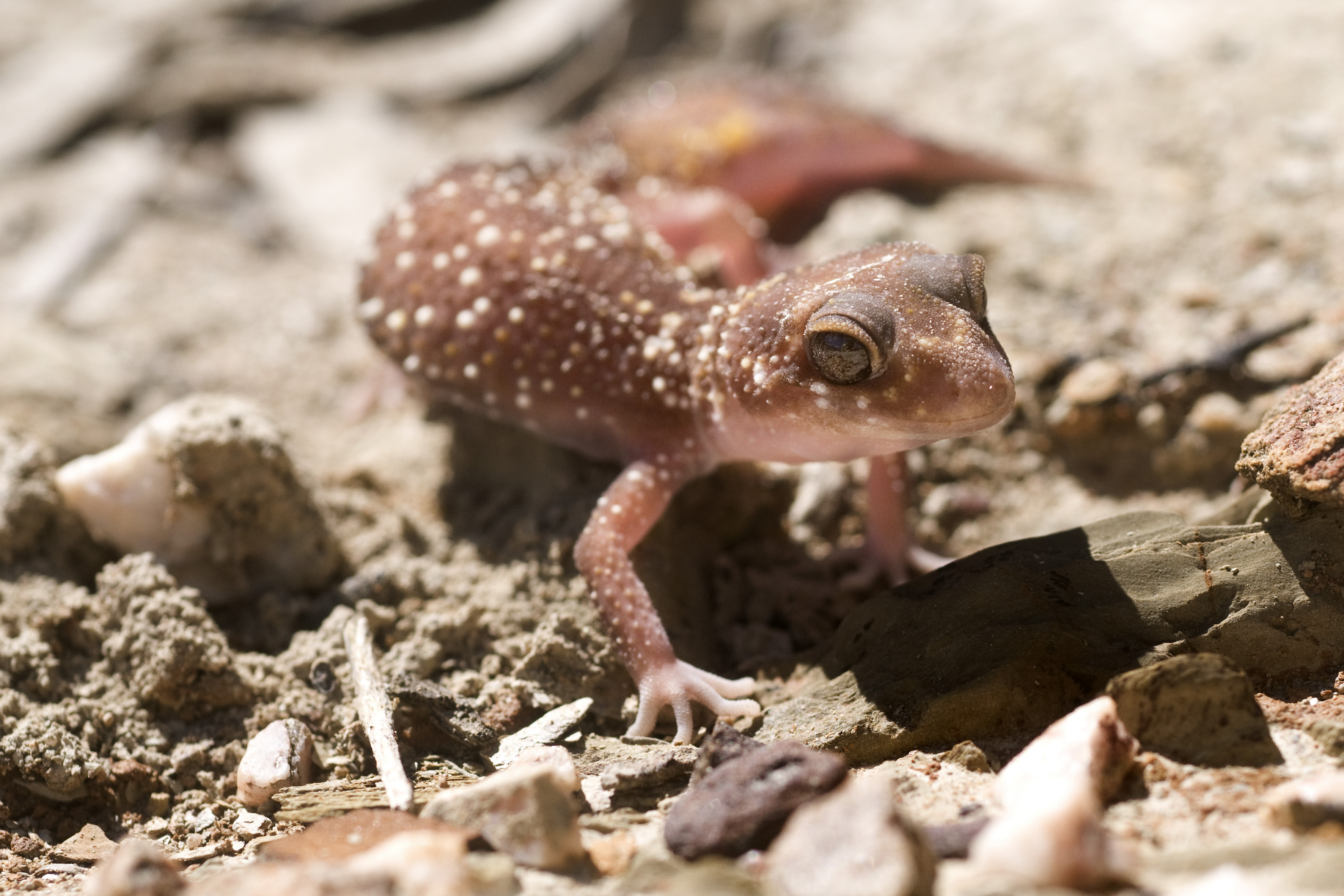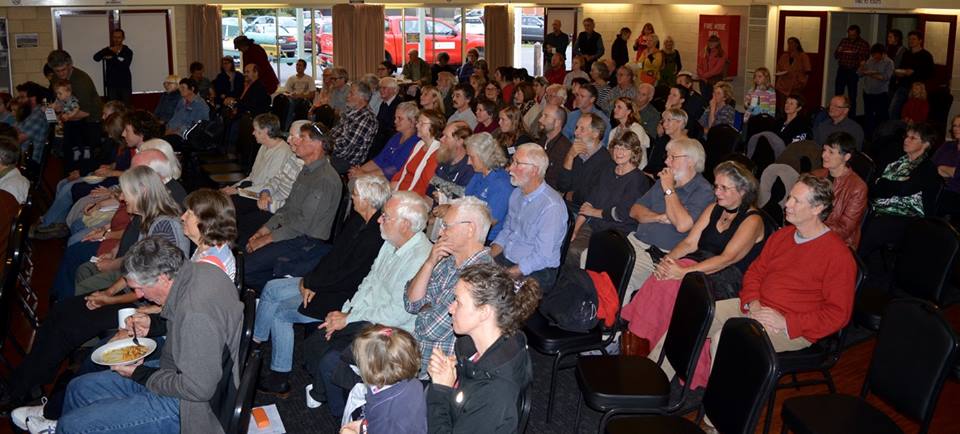Bird of the month: Wedge-tailed Eagle
Posted on 30 December, 2024 by Anna
Bird of the month: Wedge-tailed Eagle (Aquila audax)
Welcome to Bird of the Month, a partnership between Connecting Country and BirdLife Castlemaine District. Each month we’re taking a close look at one local bird species. We’re excited to join forces to deliver you a different bird each month, seasonally adjusted, and welcome suggestions from the community. This article was written by Damian Kelly and Jane Rusden from BirdLife Castlemaine District, accompanied by photos from them both.
Wedge-tailed Eagles, or ‘Wedgies’ as they are often known, can be seen all over the Mount Alexander region, usually soaring on thermals at great heights, identifiable by their characteristic wedge shape tail and broad up-swept wings. A common enough, though still awe inspiring sight when I’m doing Connecting Country’s Woodland Bird Survey on private land, on a peak along Fogarty’s Gap Road. Recently a pair cruised over the Campbells Creek bush, just high enough to clear the ridges, sending some of the local birds into a panic of alarm calls. Interestingly, wedgies don’t always illicit alarm calls from other bird species. My best guess is that potential prey bird species know if a Wedgie is on the hunt or not, and therefore if they are in danger of becoming a meal.
Australia’s largest bird of prey and one of the largest eagles in the world, it is more common across the inland plains and it tends to avoid human habitation when building a nest. Wedge-tailed Eagles are quite adaptable when breeding with nesting sites ranging from large trees on hillsides, low trees in desert areas, on cliffs, in rain forests and even on the ground on islands. Density of bird territories varies widely. In years of abundant rabbit populations pairs may nest within 700m of each other. In more difficult years a territory may be several square kilometres and some pairs will not breed. Nest are seemingly enormous heaps of messy sticks.
Diet is varied with rabbits composing a significant proportion when available, but the eagles are known to take a variety of carrion and road-kill when available as well as wood duck, ibis, raven, galah, cockatoo and even other raptors. They are also known to harass other predators such as other raptors and even foxes to steal food.
The colour of their plumage varies – very dark birds are often older adults, but this is not always the case, with some lighter coloured birds recorded breeding. At times, fledglings can even be darker than their parents. So you cannot reliably rely on colour to estimate age.
There is a lot of misinformation prevalent about eagles and bounties were paid to exterminate them up until quite recently. They are now a protected species, but sadly there are still cases of eagles being shot and poisoned with some recent high profile court cases in Gippsland. Detailed studies have shown that in reality eagles take a very small proportion of lambs lost each year.

Wedge-tail Eagle on a road side. Note the ‘trousered’ legs and powerful talons. Photo by Jane Rusden.
Presenting our 2023 Annual Report: ready for download
Posted on 31 October, 2023 by Ivan
Connecting Country’s annual report 2023 is now available for you to catch up on our highlights from 2022-2023. Along with brief updates from our President, Treasurer and Director, the report gives an overview of our work – spanning landscape restoration, community engagement, monitoring and Landcare support – with plenty of gorgeous pictures!
Our annual report is also another opportunity to say a huge thank you to our many valued funders, donors, volunteers and supporters in the community, and our hardworking staff and committee of management.
We hope you enjoy learning a little more about our work and achievements this past year, which has been busy, challenging and enjoyable!
To view the Connecting Country annual report 2023 as a document – click here
Helping us deliver more habitat restoration!
By making a regular or once-off donation you will directly support habitat restoration in the Mount Alexander region of central Victoria, Australia.
Since 2009 we have worked with over 330 landholders and groups to do restoration works on over 13,000 hectares across our region, providing refuge for wildlife through planting of locally indigenous plant species, installation and monitoring of nestboxes, wildlife surveys and community education programs.
Connecting Country (Mount Alexander Region) Inc is a registered charity with deductible gift recipient (DGR) status.
All donations of $2 or more to Connecting Country are tax deductible.
Secure online payment by credit or debit card
Head to our secure online payment site by clicking below:
If you’re inspired to get more involved with Connecting Country please:
- Become a member (if you’re not already) – click here
- Support us with a donation – click here
- Consider volunteering with us
- Get in touch via email (info@connectingcountry.org.au) or phone (0493 362 347)
Check out this cute as a button Phascogale (and thank you Arborcam!)
Posted on 29 May, 2023 by Jess
Here at Connecting Country, we are very grateful to all who donate their time or hard-earned cash to Connecting Country. It really takes a village to get things done!
We use remote cameras to supplement our volunteer nestbox monitoring program and to check any nest boxes that we can’t quite reach with a ladder.
We recently took our monitoring cameras to the manufacturer, Arborcam, for repairs and were delighted that Blair kindly donated us the newest model! You can see some of the fantastic, clear (and adorable) footage of our favourite dasyurid marsupial, the Brush-tailed Phascogale (or Tuan) that Blair provided using the Arborcam Mk 3 (our cameras are pre-mk 1).
Thank you for your generous donation Arborcam! We can’t wait to put them into action.
We loan our cameras out to Connecting Country and Landcare members in our local area for nest box monitoring. Or, they can be purchased from Arbocam: Click Here
For more about our monitoring program, how to get involved or to donate to the program, please Click Here
Recognising our volunteers and donors: 2021 celebration
Posted on 23 December, 2021 by Ivan
We love our volunteers and donors and could not do what we do without them. Our management committee is run by volunteers, our monitoring programs rely on skilled citizen scientists, our landholders ensure landscape restoration is maintained, and others help with events, Landcare, engagement and in countless other ways. We appreciate their dedication to our vision of increasing, enhancing and restoring biodiversity across central Victoria.
With few opportunities for large grants to assist our projects, we have relied more and more on our volunteers, fundraising and donors, as well as diversifying our ‘fee for service’ model. We have been fortunate to receive generous donations from local families and organisations, which have supported our monitoring and restoration projects.
It was a great pleasure to host a humble thank-you celebration for our volunteers and larger donors on the evening of Wednesday 8 December 2021 at The Hub Plot, behind our office in Castlemaine, Victoria.
Although a chilly summer evening for central Victoria, we still enjoyed COVID-safe celebratory drinks and snack packs in the leafy Hub Plot garden. Our Monitoring Coordinator, Jess Lawton, provided a short summary of our monitoring achievements over the last year, followed by plenty of chatting and laughter. Thank you to everyone who came and made it a wonderful evening with great company. Special thanks to Lou, Jane R, Brendan and Duncan for setting up and helping the evening run smoothly, and to Heather and Neil for the lovely venue.
We are blessed to have an engaged and enthusiastic community who support us to check in on our local biodiversity, and deliver monitoring, engagement, Landcare support and landscape restoration across our region. If it wasn’t for your hard work, we simply would not be able to continue our valuable long-term biodiversity monitoring, engage our community in caring for our local landscapes, or empower landowners to manage their land as wildlife habitat.
To everyone who has helped Connecting Country in 2021: a big thank you! We are so grateful for your support and encouragement.
To find out more about volunteer and donation opportunities at Connecting Country, please – click here
Please enjoy the following photos by Lou Citroen, capturing the beauty of our volunteer celebration on a chilly summer’s evening in Castlemaine.
Camp Out Collage 2021
Posted on 13 May, 2021 by Asha
Thank you to everyone who contributed to the ‘Camp Out Collage’ as part of our virtual 2021 Camp Out on the Mount. Special congratulations to our prize winners – Theo, Dale, Lynda, Liz, and Eliza!
The collage is made up of photos from camping, pledges to care for the land, and words of love for Leanganook.
Photos and words from Theo Mellick-Cooper, Dale Every, Lynda Conn, Liz Martin, Eliza Alford, Asha Bannon, Frances Howe and Bronwyn Silver.
The Camp Out on the Mount pages will remain on our website for those who would like to continue exploring them – click here
Bird of the month: Batman and Robin
Posted on 23 July, 2020 by Ivan
Welcome to our sixth Bird of the month, a partnership between Connecting Country and BirdLife Castlemaine District. Each month we’re taking a close look at one special local bird species. We’re excited to join forces to deliver you a different bird each month, seasonally adjusted, and welcome suggestions from the community. We are lucky to have the talented and charismatic Jane Rusden from BirdLife Castlemaine District writing about our next bird of the month, with assistance from the brilliant Damian Kelly.
Black-faced and White-bellied and Cuckoo-shrikes – aka Batman and Robin
You may have felt and seen the stirrings. The critters in the bush are gearing up for the new breeding season, just as the wattles and Hakea have begun to bloom. A couple of weeks ago I sighted my first White-bellied Cuckoo-shrike since last summer. As I took the time to observe its behaviour and plumage as it moved through the tree canopy, I was reminded about how hard it can be to distinguish White-bellied Cuckoo-shrikes from Black-faced Cuckoo-shrikes. Each species has several morphs. This post focuses on the Central Victorian morphs, to avoid getting too complex.
My first source of information is always Damian Kelly. He reported that the Handbook of Australian, New Zealand and Antarctic Birds (HANZAB) prefaced many comments on cuckoo shrikes with ‘not well known’. This I found interesting, as the Black-faced Cuckoo-shrike is a moderately common and widespread partial migrant, even if the White-faced Cuckoo-shrike is uncommon, though widespread and a partial migrant or resident (depending on which book you read). I’d expected more would be known about these two species.
There are many similarities between them. Both species of Cuckoo-shrike display a graceful undulating flight, soft grey and white colours with black markings, and similar size, bill and body shape. The immature birds are especially difficult to distinguish, as is often the case. Both species are often seen as individuals or in pairs. However, occasionally I’ve seen Black-faced Cuckoo-shrikes in huge flocks moving through treetops in our local forests, and after the breeding season White-bellied Cuckoo-shrikes can be observed in flocks of up to 12. Often it’s their distinct call which signals their presence.
Let’s look at some of the differences between these two species, and what to look for when identifying them. There are several characteristics that are useful. Their calls differ, the Black-faced having a soft churring call and the White-bellied a sharper sounding ‘quizeek-quizeek’ (see links to calls below). Both species can do a wing shuffle upon landing on a branch, but the Black-faced Cuckoo-shrikes shuffles its wings every time and with a very obvious and pronounced movement.
Visually the colouring in adult birds is a little different. The Black-faced is just as its name suggests, its white belly only extends to below its chest and it is a slightly larger bird. In-flight the extended tail and wings appear black. The White-bellied has a more obvious and brighter white belly (although there is a dark morph, further confusing the issue but rarely seen in Central Victoria) and a black stripe from the bill to the dark eye.
The immature birds of both species are very hard to tell apart. Both are soft grey with a full white belly and chest, and both have a black stripe through the eye like the adult White-bellied Cuckoo-shrike. However, the black eye stripe in the Black-faced Cuckoo-shrike runs from the bill and extends past the dark eye.
In conclusion, it’s all very confusing. However, you could say the Black-faced Cuckoo-shrike has a Batman face mask but without the whole hood, and the White-bellied Cuckoo-Shrike has an eye mask like Robin. Little superheroes – who’d have thought?
To read more about this wonderful bird on Geoff Park’s ‘Natural Newstead’ blog – click here
To learn more about the dark morph of the White-bellied Cuckoo-shrike – click here
To hear the call of the Black-faced Cuckoo-shrike – click here
To hear the call of the White-bellied Cuckoo-shrike – click here
A big thank you to contributors to this edition of Bird of the Month – Jane Rusden, Damian Kelly and Geoff Park – for their amazing knowledge and advice.
Tis the season to be planting
Posted on 4 June, 2020 by Ivan
Connecting Country are busily preparing to roll out our 2020 revegetation projects across the region over the next few months, with an abundance of moisture and perfect growing conditions. Recent rainfall in central Victoria means planting conditions are likely to be particularly good compared with in recent years, which has us excited about the prospects for the 4,500 plants ready at the Connecting Country depot.
Of the 4,500 plants, 1,500 have been provided by TreeProject and the remaining provided through Connecting Country’s funded landscape restoration projects TreeProject is a wonderful not-for-profit group that connects landholders and community groups with volunteers who propagate low-cost indigenous seedlings to revegetate degraded landscapes. TreeProject is able to keep seedling costs as low as possible thanks to the commitment and enthusiasm of the volunteers who propagate the seedlings in their backyards from materials TreeProject supplies.
Our Landscape Restoration Coordinator, Bonnie Humphreys, has spent the past few weeks preparing for plant delivery and ensuring the plants are in top condition. Bonnie said ‘Connecting Country has 23 landholders signed up for the current 2020 batch of plants and projects, but we will be looking to expand to reach further landowners if more funding comes along. We are very lucky to have some terrific local plant suppliers, such as Newstead Natives, an indigenous plant nursery that propagates local plants for our region for habitat restoration’. Please enjoy some photos of the delicious plants, with our staff members Bonnie Humpheys, Jacqui Slingo and Ivan Carter.
Over the past decade, Connecting Country has worked with over 250 landholders and groups to enhance more than 10,000 hectares of habitat across the Mount Alexander region of central Victoria. This equates to approximately 6 percent of the Mount Alexander Shire. ‘It has been my pleasure to again be part of delivering Connecting Country’s revegetation program this year. We have some great projects enabling us to support landholders to restore and create valuable habitat across the shire.’ said Bonnie.
Unfortunately, we do not have any current capacity for additional landowners to join our restoration projects, but are actively seeking further funding. We do encourage landowners to fill out our expression of interest form, or contact us for advice how to conduct restoration work on their properties for optimal biodiversity outcomes. Once we have your details on file, we can let you know of opportunities for assistance as they arise. To access the expression of interest form – click here
To find out more about our current projects or discuss your eligibility, please email us at info@connectingcountry.org.au. If you have filled out an expression of interest form in the past 12 months, we have you on file and you don’t need to fill in another form, but you can always let us know you are still interested via email.
Bird of the month: Swift Parrot
Posted on 21 May, 2020 by Ivan
Welcome to our fourth Bird of the month, a partnership between Connecting Country and BirdLife Castlemaine District. Each month we’re taking a close look at one special local bird species. We’re excited to join forces to deliver you a different bird each month, seasonally adjusted, and welcome suggestions from the community. We are lucky to have the talented and charismatic Jane Rusden from BirdLife Castlemaine District writing about our next bird of the month, with assistance from the brilliant Damian Kelly. You may be familiar with the fourth bird off the ranks.
Swift parrot (Lathamus discolor)
It is the season to be looking out for and recording sightings of the critically endangered Swift Parrot, or Swifties as they are affectionately known. Having summered and hopefully bred in Tasmania, they migrate to South Eastern Australian mainland in mid autumn, for the winter months. As their name suggests, they are SWIFT. They fly fast, they eat fast and they call kind of fast. Beth Mellick at the Wettenhall Environment Trust in Castlemaine coordinates records of sightings in Mount Alexander Shire, so let her know if you see Swift Parrots (including when, where and how many).

Stunning photo of a Swift Parrot by Leigh Pieterse. Swifties are VERY difficult to photograph at all, let alone this beautifully. We are very grateful to Leigh for giving us permission to use his photo.
Tasmania is the breeding ground for Swift Parrots, in the central north and along the eastern coasts. In autumn they migrate and scatter throughout the Great Dividing Range through Victoria, New South Wales and even southern Queensland. Given there are only about 2,000 individuals remaining, they can be very hard to find. However, they can also be heard and seen in flowering eucalypts in parks and gardens.
Swift Parrots are rare due to disruption to their breeding on two fronts. Logging of old-growth forest has reduced their habitat to dangerously low levels and reduced suitable nesting hollows. Additionally Sugar Gliders, which are introduced to Tasmania, can aggressively out-compete them and prey on eggs, chicks and adult birds. Swift Parrots face an up hill battle for survival, and a lot of effort goes into monitoring them. Given every sighting provides valuable data, I thought we’d look at Swifties, what to look for and how to identify them.
Swift Parrots are not easy to identify. Did I mention they are Swift! Also they like to hang out in mixed flocks with other lorikeets, and they are very hard to tell apart when in flight and feeding in the tree tops, as they all look brilliant green with red faces. In Central Victoria, the main species to confuse with Swift Parrots are the Musk Lorikeet and perhaps the immature Crimson Rosella. In the stunning photo above by Leigh Pieterse, you can clearly see the red face, including under the chin, bordered by a thin strip of yellow and the small patch of blue on the forehead. Musk Lorikeets don’t have red under the chin – they look like they are wearing a red mask across their eyes, whereas the Swift Parrot has just dipped their face in red.
Crimson Rosellas have a blue cheek running across the face from the bill (see our very first bird of the month – click here ). That’s all very well if you can see their faces – not easy as they like to feed in the tree tops of flowering gums and acacias. If lucky enough to see one, it’s often in flight – a flock speeding across the sky and they are gone. A feature to look for is the long tail (you probably won’t see that it is crimson). In contrast, Musk Lorikeets are stubby in the tail department. Muskies are flying barrels compared to elegant long-tailed Swifties. Immature Crimson Rosellas are motley green in the body, with a tail that’s green but could be turning into the adult blue, and are unlikely to be in a mixed flock with Musk lorikeets or Swift Parrots.
For more information on identifying Swift Parrots go to BirdLife Australia’s Swift Parrot Guide – click here
To listen to a Swift Parrot call recorded by local sound expert Andrew Skeoch – click here
To record Swift Parrot sightings, contact Beth Mellick – click here
Written by Jane Rusden with research assistance by Damian Kelly
Calendar competition highlights: Week 3
Posted on 7 May, 2020 by Ivan
A couple of weeks ago we announced our inaugural Connecting Country calendar competition and entries have been flowing in steadily.
Our theme is woodland birds and this photo competition is open to all Connecting Country members and people of the Mount Alexander region. The aim of the competition is to highlight our special woodland bird community and share the passion and skills of our passionate local photographers, as well as produce a beautifully printed calendar for the year 2021.
The calendar will be available to purchase and will feature the top 12 photographs, as selected by the Connecting Country team. There is a limit of two entries per photographer, and the competition opened on Monday 20 April and will close at 5 pm on Monday 18 May 2020. Both experienced and amateur photographers are encouraged to participate. Simply email your chosen images to ivan@connectingcountry.org.au by 5 pm on 18 May 2020.
We have been extremely impressed with the quality entries so far and thought we would share the highlights from this week in a gallery below.
Thank you to everyone who’s contributed so far! Keep the entries coming until Monday 18 May 2020.
Calendar competition details:
- Photos must be relevant to the theme of woodland birds and taken in the Mount Alexander region in central Victoria.
- There is a maximum of two photo entries per photographer.
- Entries must be submitted by email to ivan@connectingcountry.org.au, including the location, date and subject of the photo.
- Original photos must be at least 3 MB for image quality, but to enter please email files under 1 MB.
- Entries close on Monday 18 May 2020.
- Winning images will be selected by Connecting Country and published in a 2021 woodland birds calendar.
- There will be no commission paid to competition winners, but full recognition of your work will be featured and acknowledged.
Further details on the competition format and conditions are provided on our website: click here
Checking the health of our habitat: project update
Posted on 16 April, 2020 by Ivan
In 2009, Connecting Country created a Biodiversity Blueprint with the help of the community and our partners. From the outset, scientific monitoring has been a high priority at Connecting Country. Monitoring allows us to observe changes in biodiversity over time, which gives us valuable information for ecological decision-making.
We’ve been fortunate to have a world-class landscape ecologist, Professor Andrew Bennett, assist in creating our monitoring programs for woodland birds and the brush-tailed phascogale.
After the success of our ‘Stewards for Woodland Birds’ project, in 2018 we were delighted to announce we obtained funding from the Helen Macpherson Smith Trust to support the review and transition of our monitoring programs. Habitat ‘Health Check: empowering citizen scientists to monitor habitat health in Central Victoria’ has been the project we required to transition to a citizen science model, with volunteers managed and supported by a paid Monitoring Coordinator.
Project achievements
After two years, Habitat Health Check is nearing completion. Our aim was to create a collaborative, robust, citizen science project that monitors native animals and plants in the Mount Alexander region. The project involved reviewing our four existing long-term monitoring programs: birds, nest boxes, plants, and frogs and reptiles. We then developed a new community-driven model that empowers our enthusiastic and skilled volunteers, maintains scientific rigor, and promotes online data sharing. We’re now sharing our valuable data with the community via the Visualising Victoria’s Biodiversity online portal and the Victorian Biodiversity Atlas.
During Habitat Health Check, our hardworking volunteers collected 2,280 new bird records, bringing our total bird records to over 26,000 individual bird records, and 541 records for our nest box monitoring. This is an amazing effort from our volunteers and a huge achievement for our Monitoring Coordinator. After reviewing our existing monitoring programs and running a series of community workshops, we have focused our resources and volunteer base, ensuring we have a sustainable monitoring program for the future.
Connecting Country’s Monitoring Coordinator, Jess Lawton, said: ‘We have held many workshops and meetings over the past two years to review and refine our monitoring program to ensure we make the best use of community resources, and that our work is congruent with both Connecting Country’s goals and areas of interest in the community. We value our volunteers and have included them in every stage of the development of our monitoring programs. I believe we now have a stronger and more focused program, after careful consideration of feedback from the community, volunteers and other stakeholders’.
Latest monitoring reports
Here are the most recent reports on our nest box and woodland bird monitoring:

It is a joy to get out and monitor birds such as the lovely Spotted Pardalote (photo by Patrick Kavanagh)
Still time to get involved
We are still open to more volunteers for our bird and nest box monitoring programs, if you are keen to be involved in our ongoing monitoring for ecological change. Bird monitoring is conducted each winter and spring, and nest box monitoring is conducted in autumn. We’re closely monitoring the COVID-19 restrictions and will adjust our activities as required to keep everyone safe. For more details, please contact our monitoring coordinator Jess Lawton (jess@connectingcountry.org.au).
A mountain of monitoring data added to Visualising Victoria’s Biodiversity
Posted on 16 April, 2020 by Ivan
Connecting Country has partnered with Federation University to incorporate our monitoring data into the State Wide Integrated Flora and Fauna Teams (SWIFFT) ‘Visualising Victoria’s Biodiversity’ project, an online data portal. This will give the community, landholders and our stakeholders a chance to see how our data looks across the landscape, and will allow for easy access to the data for anyone who is interested.
With coordination by Connecting Country’s Monitoring Coordinator, Jess Lawton, the data has been submitted to SWIFFT and is expected to be available for access later this year. ‘We will be very excited to see our mountains of monitoring data on a visual platform such as VVB and we believe this will make it much easier for the community to visualise the valuable work they have been involved with for over a decade,’ said Ms Lawton.
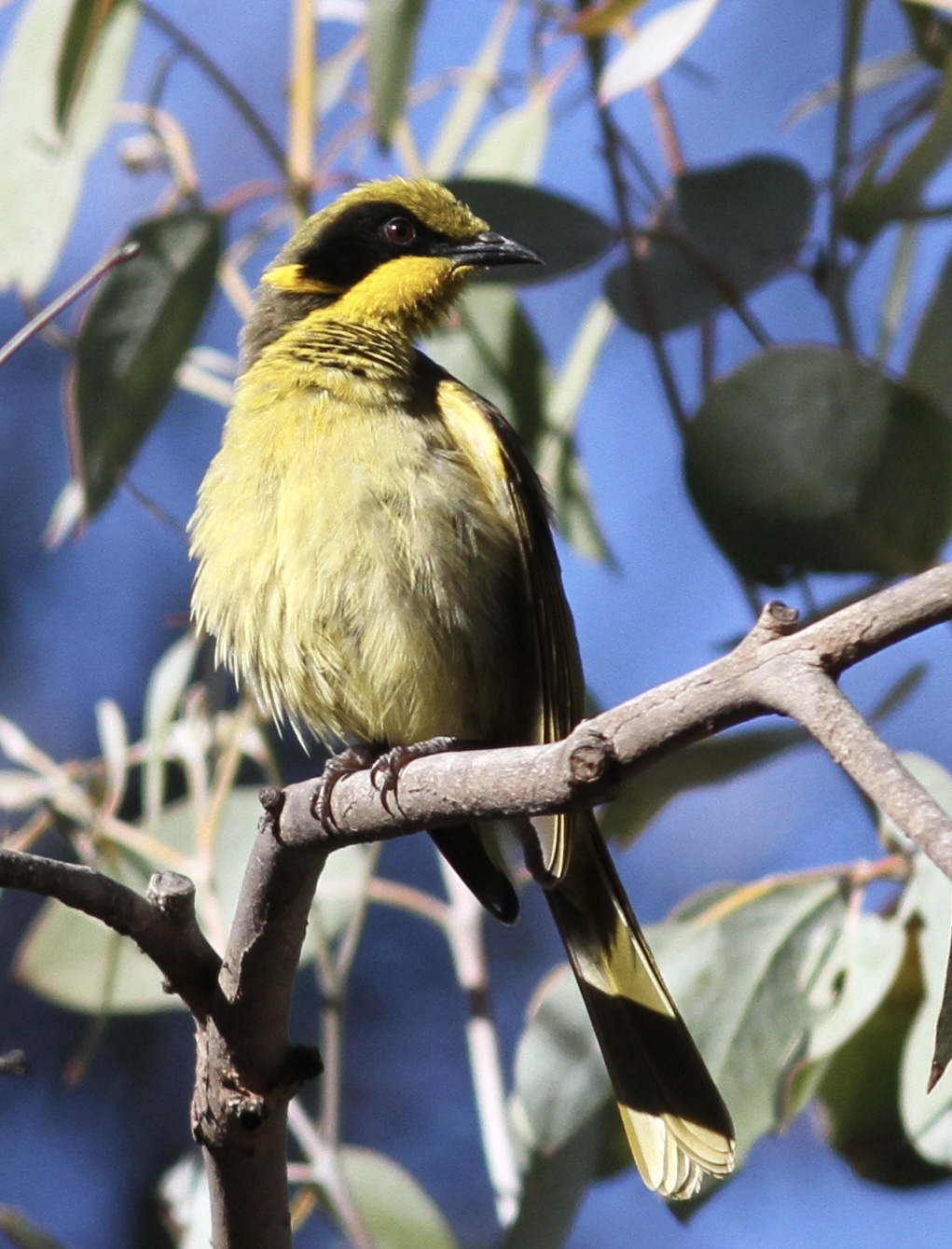
Many beautiful birds in our region are now well documented in online databases (Yellow-tufted Honeyeater photo by Jane Rusden)
Sharing our data with SWIFFT is part of our Habitat Health Check project, funded by the Helen Macpherson Smith Trust to empower citizen scientists to monitor habitat health in central Victoria. The project is nearing completion in June 2020 and has enabled Connecting Country to review our existing biodiversity monitoring programs and transition to a sustainable model for future monitoring.
Visualising Victoria’s Biodiversity (VVB) is a place to discover and share spatial information on Victoria’s environmental values, conservation activities and research. VVB is a community resource and welcomes your feedback, input and contribution. VVB brings together existing environmental data sets and information created and managed by government agencies, organisations, community groups and individuals.
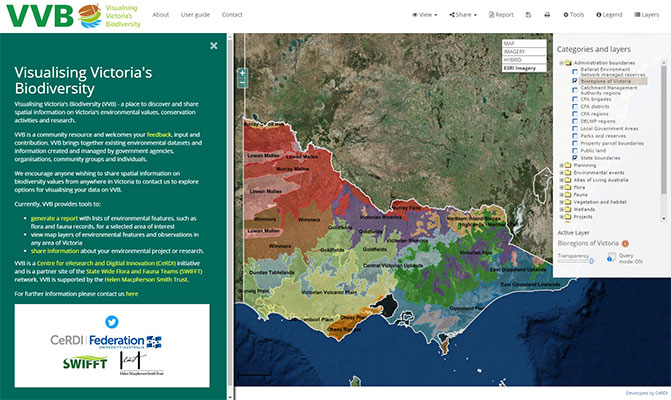
VVB allows users to create maps and view projects (image by VVB)
Connecting Country is excited by the potential to represent over a decade of biodiversity monitoring data in a simple visual format. We encourage anyone wishing to share spatial information on biodiversity values from anywhere in Victoria to contact VVB to explore options for visualising your data on VVB.
The VVB provides tools to:
- Generate a report with lists of environmental features, such as flora and fauna records, for a selected area of interest
- view map layers of environmental features and observations in any area of Victoria.
- Share information about your environmental project or research.
For further information on the Visualising Victoria’s Biodiversity project – click here.
.jpg)
All our Connecting Country monitoring sites will be added to the visual database (image by VVB)
Meet the team: who’s who in the Connecting Country zoo?
Posted on 30 January, 2020 by Frances
We thought it might be nice for our friends and supporters to get to know the team at Connecting Country, in case you don’t already. Over the coming blogs we will feature each member of our dedicated Connecting Country staff team, including a little about their interests and why they joined Connecting Country.
Here is an overview of our current staff and when you’ll usually find them in the office.
- Frances Howe – Director (Monday to Thursday)
- Asha Bannon – Landcare Facilitator (Monday to Thursday)
- Jacqui Slingo – Landscape Restoration Coordinator (Monday to Thursday)
- Bonnie Humphreys – Landscape Restoration Coordinator (Mondays and Thursdays)
- Ivan Carter – Engagement Coordinator (Tuesdays and Thursdays)
- Jess Lawton – Monitoring Coordinator (Mondays and Tuesdays)
We also want to let you know that our wonderful Asha Bannon will be taking extended leave from mid-March to September 2020. During this time, the very capable Jacqui Slingo will take over as Landcare Facilitator, while local expert Bonnie Humphreys takes the lead as Landscape Restoration Coordinator.

The team at Connecting Country, minus Ivan Carter, who is pictured below with Jess Lawton. Photos: Heather Barrett and Tanya Loos
Wattle walk and talk well received
Posted on 29 August, 2019 by Ivan
The wattles were blooming like crazy for the strong crowd of nearly 50 people at our ‘Wonderful World of Wattles’ event on Saturday 24 August at Campbells Creek in central Victoria. It was a day to remember, with sunny weather and two excellent guest speakers to educate participants about the beauty, benefits and biodiversity of the Acacia (wattle) species in our region. Connecting Country, Friends of Campbells Creek Landcare and Friends of the Box-Ironbark Forests partnered to deliver the event, which was part of our larger ‘Prickly plants for wildlife’ project funded through the North Central Catchment Management Authority.
The event kicked off indoors with retired academic and botanist Rod Orr, who has spent many years volunteering at the Bendigo Field Naturalists Club. Rod provided an excellent overview on the ecology and biological function of wattles. The audience was fascinated to learn that wattles can produce their own nitrogen fertiliser through nodules in their roots, allowing them to live in extremely low-nutrient soils. This explains why they are so useful in colonizing disturbed sites and degraded landscapes, like central Victoria!
The second part of the educational event was a walk and talk with Campbells Creek identity Ian Higgins, through the Campbells Creek Reserve at the end of Honeycomb Road. This site proved perfect for the keen audience to test their skills in identifying the large array of Acacia species that had been re-established at the site. Ian pointed out some of the finer skills in how to differentiate between species. He also gave the group a lesson in growing Acacias from seeds, and managed to get the audience to complete some direct seeding in a site dominated by Phalaris grass!
For those who could not attend, Friends of the Box-Ironbark Forests have developed an excellent 112 page book for sale, suited to beginners. In plain language, and generously illustrated, it presents 21 Acacia species that flourish in the Mount Alexander region of central Victoria. A general introduction explains different features of wattles, helping in identification and appreciation of these tenacious and beautiful plants.
Many thanks to Gen Kay, who generously volunteered her photography skills to capture the following images on the day.
Learning under the stars – Camp Out on the Mount 2019
Posted on 16 April, 2019 by Asha
Over 130 people attended the popular Camp Out on the Mount last weekend! Every year we invite people to gather for a fun night of camping and learning, to celebrate the beautiful Leanganook/Mount Alexander and the work that Landcare and Friends groups do all year round.
Saturday evening commenced at Leanganook Camping Ground with a beautiful Welcome to Country from Aunty Kerri Douglas representing Dja Dja Wurrung. She invited everyone to take off their shoes and connect to country around the campfire. Harcourt Lions Club prepared and served a delicious BBQ to the crowd. Once the coals in the campfire had settled in, the Mellick-Cooper family carried on tradition by setting up their damper-making table for all to share.
As the sun set, Mike Hayes from Parks Victoria gathered a group of about 50 together to set out on a spotlighting night walk through the bush. The group included all ages from babies to teenagers to adults. The group spotted two Brush-tailed Possums – a delight for everyone, but especially special for our visiting students from France!
On Sunday morning, campers were woken by a chorus of birds and a sunny morning. Things kicked off again with morning tea provided by Murnong Mummas, followed by a Welcome to Country and smoking ceremony with Uncle Michael Bourke. With a further welcomes from Maree Edwards MP, Connecting Country, Little Habitat Heroes, and Harcourt Valley Landcare, local legend George Milford then facilitated a discussion between local experts, including Terri Williams (Bendigo TAFE), Michael Bourke (Dja Dja Wurrung Clans Aboriginal Corporation), Ian Braybrook and Marilyn Bennet (authors of ‘Sarah’s search – a silk odyssey’). They spoke about the values of the mount from the perspectives of the environment, culture, and heritage.
Local musician Eva Popov delighted us with her song, ‘Seeds that grow’, encouraging everyone to join the chorus around the campfire. The song is about the mount and the revegetation planting done by Little Habitat Heroes.
Little Habitat Heroes volunteers ran a lovely Bush Playgroup where kids could do things like play with clay and colour in pictures of wildlife while listening to the talks and singing.
Keen participants then joined a special activity to clean native Tree Violet seed ready for planting, kindly donated by Frances Cincotta from Newstead Natives. All were encouraged to take some seed home to grow their very own Tree Violet, which provides habitat for native birds and other wildlife.
To wrap up the weekend, everyone was invited to make their way down to the Old Silk Worm Farm site to see the heritage ruins and the amazing land restoration work done. Work so far includes pine removal at past Camp Out on the Mount events, and revegetation of 900 plants by Little Habitat Heroes with support from Connecting Country. Free ‘Camp Out on the Mount’ t-shirts, designed and printed by Big Tree T-shirts and funded by Mount Alexander Shire Council, were a great souvenir for people to take home.
This free annual event was organised by Connecting Country, Little Habitat Heroes and local Landcare groups, supported by funding from North Central Catchment Management Authority through the Victorian Landcare Program, and Friends of the Box-Ironbark Forests. Connecting Country and Little Habitat Heroes would like to say a huge ‘thank you’ to everyone who helped to make the weekend a success, including everyone who volunteered their time to make sure things ran smoothly.
A gallery of photos to say Merry Christmas from the Connecting Country team
Posted on 21 December, 2017 by Tanya Loos
It has been quite a year at Connecting Country! We would like to warmly thank all of our friends and supporters, our landholders and volunteers, the many groups we work with, and our funders for their ongoing involvement and support of Connecting Country.
We have some exciting on ground works and community engagement programs planned for 2018, and we very much look forward to announcing these early next year.
Bonnie and Tanya have compiled a gallery of flora and fauna pics from the year to scroll through. Many of these photos have been sent in to us by you, our subscribers (thank you!). The beauty, colour and variety of these photos is a testament to the rich and abundant landscape we live in, and to our enthusiasm for capturing this beauty.
We wish you all a very Merry Christmas, a peaceful holiday season, and a wonderful 2018…
Merry Christmas from Connecting Country – our 2016 wrap and our 2017 plans
Posted on 22 December, 2016 by Connecting Country
2016 has been an exciting year for Connecting Country staff and committee of management. We have been busy helping landholders with on-ground works, supporting landcare, monitoring populations of plants and animals and engaging with our community of amazing supporters, members and volunteers. We are all so proud to have had the opportunity to work with the people and environment across the Mount Alexander region to do all of these activities.
In 2016 we focused on raising the profile of woodland birds and growing our partnerships with fellow organisations. This enabled us to work cooperatively with the Friends of Box Ironbark Forests, North Central Catchment Management Authority, Mount Alexander Shire Council, Dja Dja Wurrung Clans Aboriginal Corporation, Parks Victoria, Castlemaine Festival of Gardens, Castlemaine Agricultural Society and of course lots of our local landholders and volunteers. We would like to thank all involved and our project funders over the last twelve months.
We have also been planning for our future and 2017 promises to be as invigorating. We currently have ten projects on the go and look forward to continue rolling them out into the New Year. We are particularly looking forward to the Camp Out on the Mount event, celebrating the achievements of the the Connecting Landscapes program which concludes in June and a workshop series around Water in our Landscape. Watch this space to find out more!
We have created a snapshot from 2016 events and activities in the gallery below, see if you can see you!
PS. Please note our office will be closed from the 24th of December 2016 until the 3rd of January 2016.
FOBIF Tree exhibition moves to Newstead
Posted on 30 May, 2016 by Connecting Country

Long-leaved Box Eucalyptus goniocalyx, juvenile leaf. From Strangways
Photo by Patrick Kavanagh, September 2014
The Friends of the Box-Ironbark Forests exhibition, Trees in the Mount Alexander Region, is moving to the new Newstead Railway Arts Hub after a month at TOGS café in March.
The show in Newstead will run throughout June 2016. It will include the photos from the TOGS show and a slide show which will have at least one image from people who sent in photos for the FOBIF Flickr site after a call for photos in January. There are 25 framed photos which are all are for sale with proceeds going to FOBIF.
The Arts Hub show will be open at weekends and the Queens Birthday holiday (Monday 13 June). Opening hours are 10 am to 4 pm. The address is Dundas Street, Newstead (directly across from Railway Hotel). If you would like to view the exhibition outside these days/hours, or help with staffing the show, contact Bronwyn Silver on 5475 1089.
The opening will be at 10.30 on Saturday 4 June 2016. There will be refreshments and everyone is welcome. Bernard Slattery from FOBIF will open the show.

‘Death Throes.’ Yellow Box Eucalyptus melliodora. From Rise and Shine Bushland Reserve
Photo by Damian Kelly, November 2015
Trees of the Mount Alexander Region
Posted on 26 February, 2016 by Connecting Country
 A photographic exhibition Trees of the Mount Alexander Region will run at Togs Place café from 26 February until 31 March 2016.
A photographic exhibition Trees of the Mount Alexander Region will run at Togs Place café from 26 February until 31 March 2016.
The exhibition has been coordinated by the Friends of the Box-Ironbark Forests (FOBIF) and aims to highlight the amazing variety to be seen in our local indigenous trees. Even those trees of the same genus—for example, Eucalyptus—can exhibit a wild variety of shape and colour, as well as providing a home and other resources for an extraordinary diversity of wildlife.
The exhibition photos have been selected from over 125 that were submitted to FOBIF during December and January. In June 2016 the exhibition will have a second showing at the new local arts venue, the Newstead Railway Arts Hub. At this latter exhibition, at least one photo from each contributor will be included in a continuous slideshow.
Togs Place can be found at 58 Lyttleton Street, Castlemaine. Photos will be for sale, with proceeds going to FOBIF to cover costs.
(Also of interest to tree-lovers, the Bjarne K Dahl Trust and the Royal Society of Victoria are presenting a one-day symposium in Mebourne on 18 March 2016 highlighting eucalypt diversity and conservation. For further details, see their website – CLICK HERE)
Alan ‘Curly’ Hartup – Newstead photographer and naturalist
Posted on 24 September, 2015 by Connecting Country
Via Geoff Park, Ken Hartup has made us aware of a wonderful exhibition of nature photographs by leading amateur photographer and long-time resident of Newstead, Alan Jesse Hartup (1915 –2004), which will be opened at the Newstead Railway Arts Hub on Saturday 10 October 2015 at 3pm. Viewings thereafter are by appointment through until the 24 October.
This exhibition is largely of bird life in Newstead and the surrounding districts, from Alan’s vast array of black and white photographs and colour slides. This selection of 20 works of black and white and prints from colour slides, span over 60 years of Alan’s impressive output. Beginning with his beloved 35m Voigtlander camera, he progressed to the brilliant level of work he achieved with his Mamiya and Rollieflex 2¼ square cameras and his great ability with dark room techniques.
Alan has been represented widely in amateur circles and has been a central figure in promoting, selecting and judging photography in Victoria and interstate. In preparing for this exhibition we have been reminded what a wonderful legacy Alan has left with images of the beauty and richness of our surroundings. He was a man at one with the natural world and one who took a vital interest in our environment and how to care for it. The exhibition was prompted by local field naturalists Geoff Park and Mrs. Joan Butler.
The attached flyer has further details (CLICK HERE).
Phascogales (Tuan) Competition
Posted on 16 March, 2009 by Connecting Country
The Norman Wettenhall Foundation is giving away prizes to groups (to the value of $300) and to individuals (to the value of $150) who enter information about where they have seen Brush-tailed Phascogales (Tuans) in the Mount Alexander region. Click here to view the interactive mapping tool provided by Spatial Vision. Enter your Phascogale (Tuan) sighting and you are automatically in the draw. Competition closes 26th March. The prizes will be drawn at the Connecting Country Reference Group meeting 26th March.
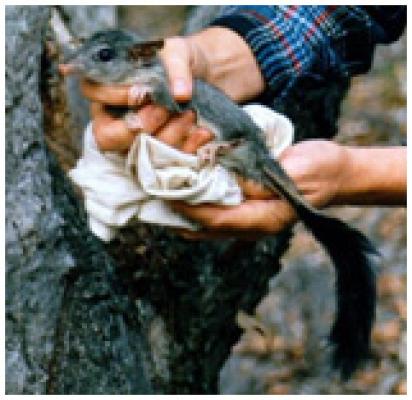
Phascogale




































